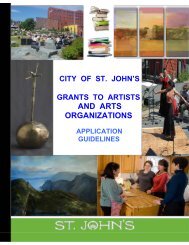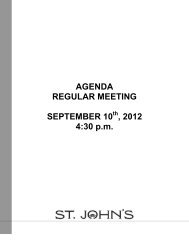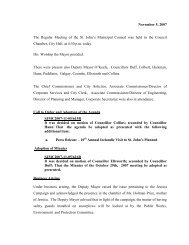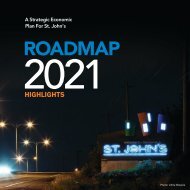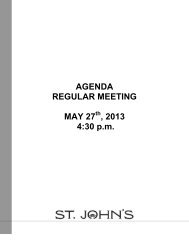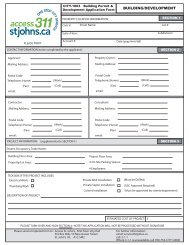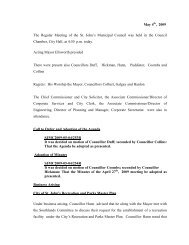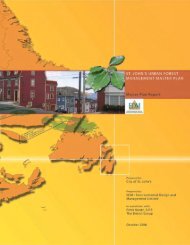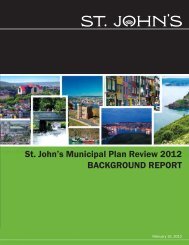Metrobus Transit Study.pdf - City of St. John's
Metrobus Transit Study.pdf - City of St. John's
Metrobus Transit Study.pdf - City of St. John's
Create successful ePaper yourself
Turn your PDF publications into a flip-book with our unique Google optimized e-Paper software.
<strong>St</strong>. John’s Transportation Commission (<strong>Metrobus</strong>) 2011<br />
Market Assessment and <strong>St</strong>rategic Directions <strong><strong>St</strong>udy</strong> – Part D: <strong>St</strong>rategic Directions<br />
14.0 FARE STRATEGIES<br />
14.1 M-Card<br />
The implementation <strong>of</strong> the M-Card in 2006 replaced the 10 Ride Card, Monthly and Semester Pass<br />
paper media. Its introduction has increased revenue security as well as provided the flexibility to<br />
introduce other fare payment options in the future. It has also been beneficial to transit users as the<br />
added convenience allows passengers to fill up their cards at stations and on the internet and not be<br />
left looking for exact change as they board the bus. The various surveys have found that the M-Card<br />
has been significantly more popular than cash as a means <strong>of</strong> fare payment and M-Card usage covers<br />
about 75-80 percent <strong>of</strong> riders 7 .<br />
It is recommended that <strong>Metrobus</strong> continue to expand the M-Card system and introduce more<br />
outlets and technology upgrades. M-Card also <strong>of</strong>fers the opportunity to develop a combined transit<br />
and parking pass. By recognizing that some transit users will occasionally require a car for specific<br />
trip making, having the M-Card compatible with parking payment systems will increase the<br />
convenience <strong>of</strong> the card for transit users, particularly at strategically located park and ride lots.<br />
M-Card is also very adaptable to special promotions, rewards programs and affinity programs with<br />
retailers or other partners. <strong>Metrobus</strong> is a transit industry leader with this technology and should<br />
continue the momentum already developed.<br />
14.2 Fare <strong>St</strong>rategy and Affordability<br />
Fare increases, no matter how small, are viewed negatively by passengers especially if they perceive<br />
that the service they are receiving has not improved. However, fare increases are needed to keep up<br />
with the rising costs <strong>of</strong> operating and maintaining the system (e.g. fuel, wages, etc.).<br />
Ideally, small fare increases should be implemented annually during the budgeting process to avoid<br />
large one-time increases to “catch up”. Larger fare increases should be tied to the introduction <strong>of</strong><br />
new services, extended service hours or improved frequency <strong>of</strong> service, provision <strong>of</strong> new equipment<br />
or in response to extraordinary circumstances (e.g. sudden, dramatic increase in fuel costs). This<br />
approach to setting fares will give customers the impression that they are getting appropriate value<br />
from the increased fare.<br />
<strong>Metrobus</strong> has several fare categories, with discounts to specific demographic groups (seniors,<br />
students, children) <strong>of</strong>fered for 10-ride tickets and monthly passes.<br />
There is also a single cash fare for all age categories (with the exception <strong>of</strong> child fares), which is<br />
effective and appropriate. <strong>Metrobus</strong> should move as quickly as possible to a single cash fare for all<br />
categories as this will greatly simplify ridership reporting and operations while reducing potential for<br />
conflict between drivers and users.<br />
Pricing strategies and incentives should continue to move as many users as possible from cash to<br />
tickets and passes on the M-Card. While this reduces the average fare, the conversion <strong>of</strong> occasional<br />
cash riders to become more regular transit users is a key growth strategy.<br />
The practice <strong>of</strong> discounting fares for key promotions (i.e. Eighties Promotion in August) is an<br />
effective means <strong>of</strong> getting people to try the service or use it more. The Eighties Promotion reduced<br />
7 This statistic was noted from the passenger surveys. Actual system usage <strong>of</strong> M-Card is between 60 to 65 percent <strong>of</strong><br />
riders.<br />
Dillon Consulting Limited Page 91




